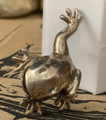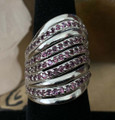 Loading... Please wait...
Loading... Please wait...- Home
- Voodoo Estate
- Aunt Nadiene's Thai 22K White and Yellow Gold Vermeil, Fire Opal, Emerald and Almandine Garnet Gems, Naga, Chinese Dragon Ring - A Séance Spirit Reading Room Find - The Voodoo Estate
- Home
- Gemstones
- Aunt Nadiene's Thai 22K White and Yellow Gold Vermeil, Fire Opal, Emerald and Almandine Garnet Gems, Naga, Chinese Dragon Ring - A Séance Spirit Reading Room Find - The Voodoo Estate
Aunt Nadiene's Thai 22K White and Yellow Gold Vermeil, Fire Opal, Emerald and Almandine Garnet Gems, Naga, Chinese Dragon Ring - A Séance Spirit Reading Room Find - The Voodoo Estate
Product Description

Aunt Nadiene's Thai, 22k White and Yellow Gold Vermeil, Fire Opal, Emerald and Almandine Garnet Gems
Naga, Chinese Dragon Ring
It has now been just over twenty-two and a half years ago since we were called to do an estate that had been closed up for seventeen years!
The Voodoo Estate!
This type of call usually gets us excited as they are a treasure trove. Located here in Florida, there was no electricity or running water so we rigged our own lighting and in we went. If you have ever seen the Adams Family you will have some idea as to what we were greeted with! Then the attorney handling the liquidation gave us some background. The estate had belonged to an alleged powerful Voodoo Priestess/JooJoo Exorcist, grand daughter of a Marie Laveau, and favored daughter of a Marie Glapion.
These names meant nothing to us, but the late night talk of Voodoo and exorcism in the old mansion was enough to make us decide to spend the night in a hotel and return in the morning to assess the estate. The rest is history.
Our research has shown that this woman was what she claimed and was indeed descended from a long line of well known Vodoun family originating in New Orleans in the early 1800's. We were somewhat unnerved by this until we discovered they were also devout Catholics! Although I have to admit this was unlike any Catholic home we have ever been in and some of the items found inside were a little more than unnerving.
There was no feeling of dread or unwelcome in the mansion, however there was quite a bit of contraband and other items we can or will not sell here.
This is one of a few pieces from this estate we will be listing this week, so check our other listings.
We will, upon the new guardian's request, issue a named Letter of Authenticity with each piece from this estate, complying with the terms set forth to us by the estate's attorney.
Some Back Story
This is one of the two hundred and twelve assorted pieces of Thai vermeil and gemstone jewelry that were recovered from a jewelry salesman's sample case sitting on the floor in the storage closet that served her main séance and reading room. These rooms were a commercial endeavor that had a wealthy following and it is where many of the major séances of this estate were conducted. Many, if not all of her associates worked this room, conducting séances, card readings and numerous forms of divination for their clientele. Apparently this was a lucrative endeavor, as it remained active for over six decades.
Her journals list a host of well known psychics, mediums and other celebrities that would make guest appearances and that these events were booked to capacity well in advance.
Her journaled inventory tells us this is one of the rings her Aunt Nadiene had made for her by a Thai jeweler of Chanthaburi in 1956/57. This jeweler had copied a handful of gold and gemstone rings in vermeil, many of which were gifted and inherited by her niece.
While there, she purchased a sizable quantity of jewelry to be sent home for resale to their clients. Often times claiming to cast spells or attach spirits to a piece of jewelry at a client's request.
Aunt Nadiene
Although not a blood Aunt, she had been "taken into the fold as a child found" by her "mother" as she was said to refer to Marie Glapion. Further chronological investigation revealed her to be the daughter of a prostitute that was in her mother's (Marie Glapion) employ. Other notes found might lead one to believe her mother was an Algul. Described as a vampiric jinn like creature they claimed to have encountered in remote desert regions.
Our own research has not revealed very much other than Algul literally translates to "horse-leech," or "blood-sucking Jinn." An example was found in the 'Thousand and One Nights' as Amine. Although a drinker of blood, it is a Jinn, or demon that was never human. Unkillable by most means, it can be destroyed by fire and sometimes magic. Most inhabited unchartable regions of desert, but oil production has driven them from their homes and she claims "they live among us, posing no threat to adults save sexual fulfillment, but they must be watched around children and livestock."
~!~
It is not clear if Aunt Nadiene was abandoned by her mother or if the mother died, orphaning the girl, but she was apparently treated and referred to as a family member, indoctrinated along with her "niece," and for many years she was her traveling companion and guardian.
Her journals note of Aunt Nadiene's passing in 1966.
She also notes of wearing Aunt Nadiene's jewelry, "Connected to her so closely in life, it awakens psychic qualities with a feeling of devotional joy to wear them."
Other journal entries allege incidents of Aunt Nadiene, "owl shape shifting" claiming the Great Horned Owl as being her spirit guide or token spirit animal, and because of this, her taking due care in the handling of owls in her bird and reptile ceremonies, not submitting them to the torturous ceremonial deaths many other species endured during these ceremonies.
She also notes of a number of dreams in which a Great Horned Owl wearing her aunt's jewelry would appear to her. They also go into detail of her gazing into her stones (sphere's), to draw upon Aunt Nadiene's power to help her in this life.
The Ring, Its Components and Commentary
Examination reveals an unusual and well made 22k white and yellow gold vermeil, figural Chinese dragon head ring set with an outstanding array of faceted fire opal, emerald and almandine garnet gems, all further described below.
More often than not, their metal of choice was silver as she notes, "Silver is the mirror of the soul related to the moon energies. It strengthens connections of the astral and physical bodies. A metal unmatched in its psychic energies and healing abilities, I have used it as a spell medium, to heal the speech impaired and to help public speakers achieve eloquence. Induced into the drink, it has expelled the toxins that caused headaches, arthritis, intestinal and blood disorders. More importantly it attracts, enhances and stores energies of gemstones, driving out negative energies the stone may have absorbed."
~!~
The Fire Opal Gems
The single, 4.7625 and 6.35 mm, faceted round fire opal gems are prong set in the dargon's mouth and third eye. These faceted round opals are of very good cut and fine polish with a fiery internal green/red/gold opalescent flash.
In her notes she writes of fire opal; "These stones bear an energy that is predisposed for use in magic spells. They achieve invisibility for us against all malicious magic and are a source of protection in themselves."
"A money draw, it is as if a magnet to draw in wealth. It is also a healer and a stone of protection. It can be relied upon to relieve deficiencies of energy while stimulating the libido and adrenal glands."
She goes on to describe, "Susto, Mal puesto and Mal ojo works" one of her sources of fire opal were involved in with a number of journal entries which describe the cause and symptoms of these spells, such as; "Susto is a fright sickness caused by traumatic and frightening experiences often emplaced during the victim's dream state. Look for insomnia, lethargy, depression, irritability and anxiety as symptoms. Effective treatment can be affected by covering the head with a Holy Water immersed cloth keeping it moist with periodic sprinkling in addition to spitting alcohol into the patients face unexpectedly and irrigating them internally with herbs."
She writes of "Mal ojo" as being, "the evil eye cast by one blessed with the strong eye. Those that admire children without touching them are easily afflicted. The symptoms here are often diffuse so it is best to attempt cure by passing a fresh laid egg over the patient's entire body before placing it in a bowl under the patient's pillow overnight. In the morning, if the egg is cooked then treatment for mal de ojo in order."
She also writes of "Mal puesto" as the, "use of sorcery to invoke disease. This is a true hex used by bruja throughout Mexico, Central and South America. Here the Symptoms vary, as does the cure. This involves, massage, herbal treatment, prayers and invocation chants performed in conjunction with arm crossing (anointing with oil and chili powder in the sign of the cross) and herbal pepper enemas."
~!~
Our own experience with fire opal has revealed that fire opal is a variety of opal that usually has a bright yellow, bright orange or bright red background color. They receive their name from their fiery background color. Precious Opal is a name given to any opal that exhibits “play-of-color,” a flashing display of spectral colors when the opal is “played” under a light source.
Because of its play-of-color and its white body color, the opal in this ring could be called a "precious fire opal."
A few specimen of fire opal exhibit “play-of-color.” These specimens have both the fiery background color of a fire opal and the play-of-color of a precious opal. Some people call these special stones “precious fire opal.” The play-of-color can be tiny bright flashes of color when the opal is played under light, or a billowing glow contained within the stone.
~!~
The Emerald GemsSet as the dragon's eyes, these 1.7 mm bezel set emerald gems are of a rough faceted round antique cut, highly included and of good matched color. She does write of her own feelings and observations concerning emerald. Some of her journal entries read; "Naga stone of meditation with calming, protective energies that enhance all psychic abilities, quite useful in dream enhancement and manipulation. Well grounded in Femini (her spelling) Earth energies that have no ill and shield against external attacks. These stones have proven themselves as healers of the love-lorn heart, often leading to life-long relations being saved, with those expressing the deepest of emotions for their partners."
"There are many divine qualities given with this stone, which accounts for its mention in many of the mythologies. In the Christian myths, the emerald which Satan carried in his forehead fell to the ground and created the Holy Grail when he was cast out of Paradise. Hermes recorded the laws of magic upon an emerald tablet. It is the legendary Markat Mani of Rabbinical legend being one of four precious stones given to King Solomon by God."
~!~
The Almandine Garnet Gems
~!~
It's Chinese dragon depiction is heaped in regional folklore.
It is a well made dragon motif ring done in white and yellow gold vermeil and set with fire opal, emerald and almandine garnet gems as described above. It is marked "925" with no maker's or assay marks. The ring tests as .925 Sterling Silver Standard.
It is certainly a nicely aged vintage ring with an extraordinary provenance that is much nicer than our photographer has been able to depict.
~!~We have been contacted and visited by a number of people who were interested in the items from this estate since our first batch was listed. Among the buyers have been known psychics and practitioners. More than one, after adorning themselves or handling their purchase, stated "this is a woman of power!" Many of our customers, after receiving items from this estate have reported dream contacts and other unexplained phenomenon.
Unusual, authentic Voodoo Priestess Estate piece and at a bargain price!
This is truly a rare opportunity to own anything with attributes to this estate. The majority of this estate is now gone. Most of what we had left, and it was considerable, has been split up and sold to a couple of private, foreign collector practitioners and will never be available to the public again. We made the decision to do this as we have had some pretty strange visits from even stranger individuals and there have been enough unexplained phenomenon going on in the warehouse where her things were kept that many of our employees refused to go in there.
The pieces offered and sold here are some of the few remaining pieces that will ever be offered to the public.
Nice addition to any collection, wardrobe or decor, displays really well.
Really doesn't get any better than this.
There are 10 photographs, so please give them time to load, and enjoy the listing.
Buyer to pay $0.00 for Insured USPS Ground Mail with Tracking, handling and lagniappe.
Rest assured your order will be carefully packed to withstand the onslaught of the most deranged of Postal Workers.
International Buyer's, Please email us for a Shipping Quote.
Payment is due at listing end. Check our other listings, and sign up for our newsletter as new items are usually listed daily.
©Text and Photos Copyright 2001-2024 bushidobuce, all rights reserved.
~!~
























